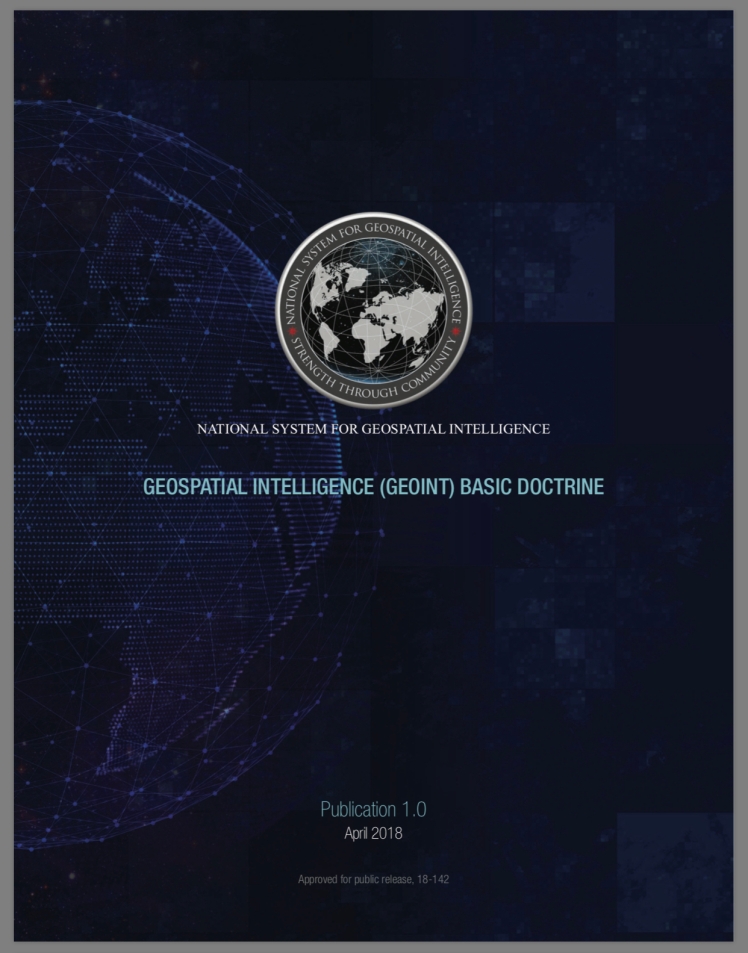INTRODUCTION
PURPOSE
Geospatial Intelligence (GEOINT) Basic Doctrine, Publication 1.0, (hereinafter referred to as Pub 1.0) provides decision makers and intelligence producers a basis for understanding GEOINT to help plan and execute their assigned missions. This document also serves as a common frame of reference for the GEOINT Enterprise Community. As the highest level of doctrine for GEOINT, NSG Pub 1.0 is written at an unclassified level and in a manner that can be readily understood by consumers (non-producers) and new producers of GEOINT. Pub 1.0 also complements the doctrine, tactics, techniques, and procedures and guidance outlined in Joint Publication 2-03, Geospatial Intelligence Support to Joint Operations.
GEOINT doctrine is prepared under the auspices of the GEOINT Functional Manager (GFM). Executive Order (E.O.) 12333 “United States Intelligence Activities” (as amended in 2008), Section 1.3 (b) (12) (A) (iii), designates the Director of the National Geospatial-Intelligence Agency (NGA) as the GFM for the U.S. Intelligence Community (IC). The title of GFM encompasses the roles and responsibilities of the Department of Defense (DoD) GEOINT Manager, as defined in DoD Directive 5105.60 “National Geospatial-Intelligence Agency,” and the IC Functional Manager for GEOINT, in accordance with applicable law and Director of National Intelligence (DNI) and DoD directives, guidance, and agreements. The GFM leads the National System for Geospatial Intelligence (NSG), as described in Chapter Five.
SCOPE.
This document supersedes Geospatial Intelligence (GEOINT) Basic Doctrine Publication 1-0, dated September 2006. As NSG community doctrine, it documents fundamental principles to guide the operation of the NSG and how it produces, maintains, and employs GEOINT. Pub 1.0 includes the legal definition of GEOINT, an overview of data used for GEOINT products, a basic understanding of GEOINT products, an understanding of the GEOINT professional work roles, and a description of the governance framework for the function of GEOINT. GEOINT is rapidly evolving to incorporate capabilities such as data analytics, artificial intelligence, machine learning, deep learning, and computer vision. However, these topics are beyond the scope of this introductory document.
APPLICABILITY.
Pub. 1.0 applies to the NSG, as defined in Chapter Five. It also applies to NSG Partners and the GEOINT Enterprise (also defined
in Chapter Five), to the extent defined by their distinct roles. As doctrine, this publication is authoritative but not directive. It does not include policy or strategy but does serve as a foundational guide for the production, maintenance, and sustainment of GEOINT across the NSG Community.
OVERVIEW.
Chapter One presents the legal definition of GEOINT, including a description of its three complementary elements: Imagery, Imagery Intelligence, and Geospatial Information. Since the term GEOINT is used broadly to include the supporting aspects of GEOINT, the chapter also addresses areas that are critical to the function of GEOINT but not included in its definition.
Chapter Two addresses GEOINT data used to create each of the three elements of GEOINT and provides information on how that data is collected. The chapter includes a section that clearly delineates different types of collection platforms, sensors, and GEOINT phenomenologies, and lists the advantages and disadvantages of each type for various circumstances and purposes. Chapter Two also describes additional types of data used for imagery intelligence and geospatial information.
Chapter Three is focused on Products. This chapter describes how GEOINT products are developed using any combination of three types of layers—Geospatial, Mission, and Intelligence—and then explains how elevation, time, motion, and activity may be added to create a more dynamic, realistic, and comprehensive GEOINT product. For the purposes of this document, products are separated into three broad categories: Mission/Event Preparation, Assessment, and Detection. The chapter describes what each of those areas encompasses and provides multiple examples of products in each category to illustrate how they may be used to support specific mission requirements.

Geospatial Intelligence (GEONIT) Basic Doctrine
#BSG